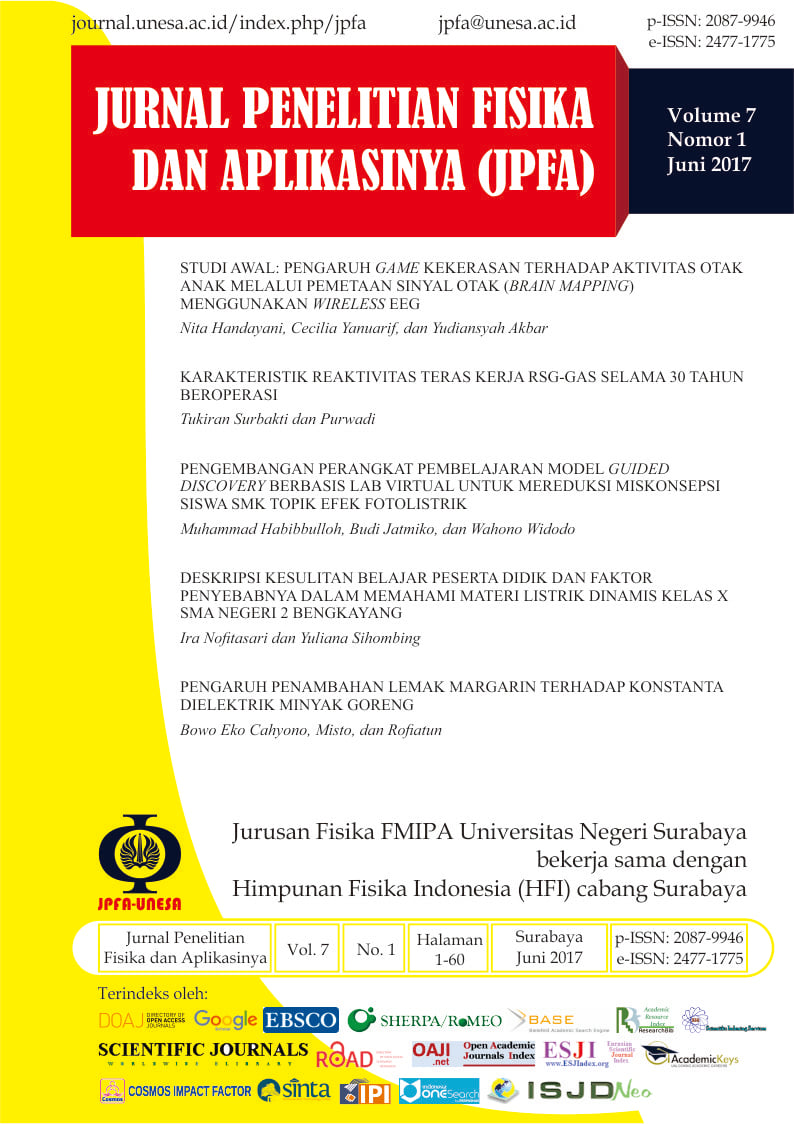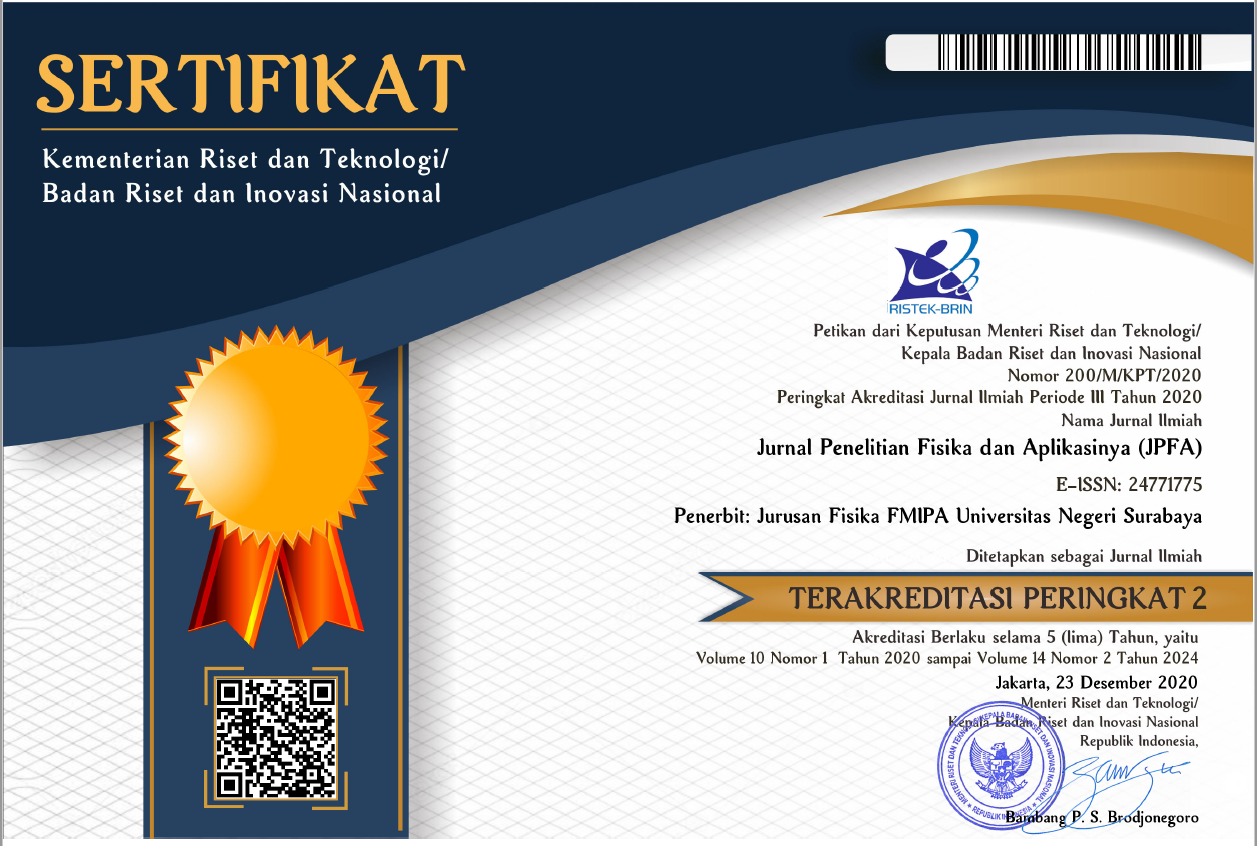PENGEMBANGAN PERANGKAT PEMBELAJARAN MODEL GUIDED DISCOVERY BERBASIS LAB VIRTUAL UNTUK MEREDUKSI MISKONSEPSI SISWA SMK TOPIK EFEK FOTOLISTRIK
DOI:
https://doi.org/10.26740/jpfa.v7n1.p27-43Keywords:
perangkat pembelajaran, model Guided Discovery berbasis lab virtual, reduksi miskonsepsi, efek fotolistrikAbstract
Penelitian ini bertujuan untuk menghasilkan perangkat pembelajaran model Guided Discovery berbasis lab virtual valid, praktis dan efektif untuk mereduksi miskonsepsi siswa SMK topik efek fotolistrik. Ujicoba perangkat pembelajaran diberikan kepada siswa kelas XII SMK IKIP Surabaya (Indonesia) program keahlian Multimedia tahun ajaran 2015/2016 menggunakan one group pre-test post-test design. Pengumpulan data dilakukan dengan observasi, tes diagnostik, dan angket. Data dianalisis menggunakan analisis deskriptif kualitatif, kuantitatif dengan metode tingkat kecocokan (Percentage of Agreement) untuk validasi perangkat, reduksi miskonsepsi melalui tes diagnostik kategori miskonsepsi didukung dengan uji-t. Temuan hasil penelitian adalah: (1) perangkat pembelajaran yang dikembangkan valid; (2) kepraktisan perangkat pembelajaran dianalisis melalui keterlaksanaan pembelajaran berkategori baik dan kendala yang ditemui berhasil diberikan solusi; dan (3) keefektifan perangkat pembelajaran dianalisis melalui reduksi miskonsepsi tes diagnostik yaitu post-test dibandingkan dengan pre-test dan nilai kategori miskonsepsi tes diagnostik di uji-t menunjukkan reduksi miskonsepsi yang signifikan. Berdasarkan temuan disimpulkan bahwa perangkat yang dikembangkan memenuhi syarat kevalidan, kepraktisan dan keefektivan untuk mereduksi miskonsepsi siswa SMK topik efek fotolistrik.
References
Novak JD dan Gowin DB. Learning How to Learn. Cambridge: Cambridge University Press; 1984.
Uzun S, Alev N, dan Karal IS. A Cross-Age Study of sn Understanding of Light and Sight Concepts in Physics. Science Education International. 2013; 24(2): 129-149. Terdapat pada: <a href="http://files.eric.ed.gov/fulltext/EJ1015829.pdf">http://files.eric.ed.gov/fulltext/EJ1015829.pdf</a>.
Gönen S. A Study on Student Teachers Misconceptions and Scientifically Acceptable Conceptions About Mass and Gravity. Published Online. Springer Science Business Media; 2007. DOI: <a href="http://doi.org/10.1007/s10956-007-9083-1">http://doi.org/10.1007/s10956-007-9083-1</a>.
Berg, EVD. Miskonsepsi Fisika dan Remediasi. Salatiga: Universitas Kristen Satya Wacana; 1991.
Masson S, Potvin P, Riopel M, dan Foisy L. Differences in Brain Activation Between Novices and Expert in Sciences During a Task Involving a Common Misconception in Electricity. International Mind, Brain, and Education Society and Wiley Periodical, Inc; 2014.
Ibrahim M. Konsep, Miskonsepsi, dan Cara Pembelajarannya. Surabaya: Unipress Universitas Negeri Surabaya; 2012.
Blas TM, Seidel L, dan Fernandez AS. Enhancing Force Concept Inventory Diagnostics to Identify Dominant Misconceptions in First-Year Engineering Physics. European Journal of Engineering Education. 2010; 35(6): 597-606. DOI: <a href="http://doi.org/10.1080/03043797.2010.497552">http://doi.org/10.1080/03043797.2010.497552</a>.
Demirci N. A Study About Students Misconception in Force and Motion Concepts by Incorporating A Web-Assisted Physics Program. The Turkish Online of Educational Technology. 2005; (4)3/7: 40-48. Terdapat pada: <a href="https://www.researchgate.net/profile/Neset_Demirci/publication/265103984_A_STUDY_ABOUT_STUDENTS%27_MISCONCEPTIONS_IN_FORCE_AND_MOTION_CONCEPTS_BY_INCORPORATING_A_WEB-ASSISTED_PHYSICS_PROGRAM/links/560d001f08aea68653d39160/A-STUDY-ABOUT-STUDENTS-MISCONCEPTIONS-IN-FORCE-AND-MOTION-CONCEPTS-BY-INCORPORATING-A-WEB-ASSISTED-PHYSICS-PROGRAM.pdf.">https://www.researchgate.net/profile/Neset_Demirci/publication/265103984_A_STUDY_ABOUT_STUDENTS%27_MISCONCEPTIONS_IN_FORCE_AND_MOTION_CONCEPTS_BY_INCORPORATING_A_WEB-ASSISTED_PHYSICS_PROGRAM/links/560d001f08aea68653d39160/A-STUDY-ABOUT-STUDENTS-MISCONCEPTIONS-IN-FORCE-AND-MOTION-CONCEPTS-BY-INCORPORATING-A-WEB-ASSISTED-PHYSICS-PROGRAM.pdf.</a>.
Salam H, Setiawan A, dan Hamidah I. Pembelajaran Berbasis Virtual Laboratory untuk Meningkatkan Penguasaan Konsep pada Materi Listrik Dinamis. Proceedings of The 4th International Conference on Teacher Education; Join Conference UPI & UPSI; 2010. Terdapat pada: <a href="http://file.upi.edu/Direktori/PROCEEDING/UPI-UPSI/2010/Book_4/PEMBELAJARAN_BERBASIS_VIRTUAL_LABORATORY_UNTUK_MENINGKATKAN_PENGUASAAN_KONSEP_PADA_MATERI_LISTRIK_DINAMIS.PDF">http://file.upi.edu/Direktori/PROCEEDING/UPI-UPSI/2010/Book_4/PEMBELAJARAN_BERBASIS_VIRTUAL_LABORATORY_UNTUK_MENINGKATKAN_PENGUASAAN_KONSEP_PADA_MATERI_LISTRIK_DINAMIS.PDF </a>.
Sugiyono. Penggunaan PhET dan KIT Sederhana untuk SMA Pokok Bahasan Alat-Alat Optik untuk Meningkatkan Keterampilan Proses dan Belajar Kooperatif. Tesis. Tidak dipublikasikan. Surabaya: Pascasarjana Universitas Negeri Surabaya; 2011.
Nivalainen V, Asikainen M, dan Hirvonen P. Open Guided Inquiry Laboratory in Physics Teacher Education. Publised Online. USA: The Association for Science Teacher Education; 2012. DOI: <a href="http://doi.org/10.1007/s10972-012-9316-x">http://doi.org/10.1007/s10972-012-9316-x</a>.
Fitriyah N dan Sukarmin. Penerapan Media Animasi untuk Mencegah Miskonsepsi Pada Materi Pokok Asam-Basa di Kelas XI SMAN 1 Menganti Gresik. Unesa Journal of Chemical Education. 2013; 2(3): 78-84. Terdapat pada: <a href="http://jurnalmahasiswa.unesa.ac.id/index.php/journal-of-chemical-education/article/view/4472">http://jurnalmahasiswa.unesa.ac.id/index.php/journal-of-chemical-education/article/view/4472</a>.
Kohar S. Pengembangan Perangkat Pembelajaran Berbasis Inkuiri Terbimbing dengan Menggunakan Program Simulasi PhET untuk Mereduksi Miskonsepsi Siswa Tesis. Tidak dipublikasikan. Surabaya: Program Pascasarjana Universitas Negeri Surabaya; 2015.
Atmoko S, Suci PM, dan Wasis. Penerapan Pembelajaran Guided Discovery Dengan Metode Demonstrasi Menggunakan PhET Simulation Dalam Menurunkan Miskonsepsi Siswa Pada Materi Listrik Dinamis di Kelas X SMAN 1 Tegaldlimo, Banyuwangi. Inovasi Pendidikan Fisika (IPF). 2015; 04(03): 122-126. Terdapat pada: <a href="http://jurnalmahasiswa.unesa.ac.id/index.php/inovasi-pendidikan-fisika/article/view/13319">http://jurnalmahasiswa.unesa.ac.id/index.php/inovasi-pendidikan-fisika/article/view/13319</a>.
Pfefferova MS. Computer Simulations and their Influence on Students Understanding of Oscillatory Motion. Informatics in Education. 2015; 14(2): 279-289. DOI: <a href="http://doi.org/10.15388/infedu.2015.16">http://doi.org/10.15388/infedu.2015.16</a>.
Thiagarajan S, Semmel DS, dan Semmel MI. Instructional Development for Training Teachers of Exceptional Children. Indiana: Indiana University Bloomington; 1974. Terdapat pada: <a href="http://files.eric.ed.gov/fulltext/ED090725.pdf">http://files.eric.ed.gov/fulltext/ED090725.pdf</a>.
Sugiyono. Metode Penelitian Pendidikan (Pendekatan Kuantitatif, Kualitatif, dan R&D). Bandung: Alfabeta; 2015.
Krathwohl DR, dan Anderson LW. Merlin C. Wittrock and the Revision of Blooms Taxonomy. Educational Psycologist. 2010; 45(1): 64-65. DOI: <a href="http://doi.org/10.1080/00461520903433562">http://doi.org/10.1080/00461520903433562</a>.
Hassan S, Bagayoko D, dan Kelley EL. Misconceptions and the Certainty of Response Index (CRI). Physics Education. 1999; 34(5): 294-299. DOI: <a href="http://doi.org/10.1088/0031-9120/34/5/304">http://doi.org/10.1088/0031-9120/34/5/304</a>.
Badan Standar Nasional Pendidikan. Model Integrasi Pendidikan Kecakapan Hidup. Jakarta: Dirjen Manajemen Pendidikan Dasar dan Menengah Depdiknas; 2007.
Suharsimi. Prosedur Penelitian: Suatu Pendekatan Praktek. Jakarta: Rineka Cipta; 2006.
Wong D, Lee P, Shenghan G, Xuezhou W, Yan Qi H, dan See Kit F. The Photoelectric Effect: Experimental Confirmation Concerning A Widespread Misconception in The Theory. European Journal of Physics. 2011. 32(4): 10591064. DOI: <a href="http://doi.org/10.1088/0143-0807/32/4/018">http://doi.org/10.1088/0143-0807/32/4/018</a>.
Krane K. Fisika Modern. Penerjemah: Wospakrik HJ. Jakarta: Penerbit Universitas Indonesia UI-Press; 1992.
Klassen S. The Photoelectric Effect: Reconstructing the Story for the Physics Classroom. Published Online. Springer Science Business Media B.V; 2009. DOI: <a href="http://doi.org/10.1007/s11191-0009-9214-6">http://doi.org/10.1007/s11191-0009-9214-6</a>.
Downloads
Additional Files
Published
How to Cite
Issue
Section
License
Author(s) who wish to publish with this journal should agree to the following terms:
- Author(s) retain copyright and grant the journal right of first publication with the work simultaneously licensed under a Creative Commons Attribution-Non Commercial 4.0 License (CC BY-NC) that allows others to share the work with an acknowledgement of the work's authorship and initial publication in this journal for noncommercial purposes.
- Author(s) are able to enter into separate, additional contractual arrangements for the non-exclusive distribution of the journal's published version of the work (e.g., post it to an institutional repository or publish it in a book), with an acknowledgement of its initial publication in this journal.
The publisher publish and distribute the Article with the copyright notice to the JPFA with the article license CC-BY-NC 4.0.
 Abstract views: 8719
,
Abstract views: 8719
, PDF Downloads: 3644
,
PDF Downloads: 3644
, PDF Downloads: 0
,
PDF Downloads: 0
, PDF Downloads: 0
,
PDF Downloads: 0
, PDF Downloads: 0
,
PDF Downloads: 0
, PDF Downloads: 0
,
PDF Downloads: 0
, PDF Downloads: 0
PDF Downloads: 0









